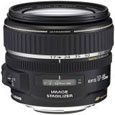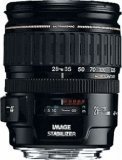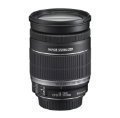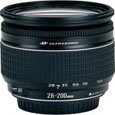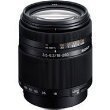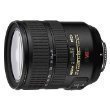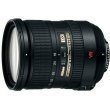DSLR Lens Selection
NOTE: The contents of this article has been superceeded by the more complete DSLR Lens Buying Guide.
A quick look at available lenses shows that there are far more lenses to chose from than DSLR cameras, yet there is a lot less information about them. Most people know by now that kit lenses only get you so far, if anywhere at all. Here we discuss how to create a personalized set of lens. Remember, those are not the only possibilities, so feel free to adapt those to your needs.
Remember that photographs are taken by a whole camera system, including the photographer. A weak link negatively affects the end-result. A poor camera, a poor lens or poor photography skills all result in disappointing pictures. The most frequent mistake of first-time DSLR buyers is to spend most of their budget on a camera body and then buy the only lens that still fits the budget - or worst, the kit lens. The first rule for choosing lenses is to allocate enough money. As it goes for choosing a digital camera, the two most important things to consider are your subjects and your medium.
Lets start with the practical. How frequently are you willing to change lenses? Are willing to do it in the field? The less you are willing to change lenses on location, the more generic your chosen lens will have to be. This often results in some compromise on image quality or versatility. One who does not want to change lenses, should not get more than one. Having too many lenses results in many of them left behind.
Are weight and size important? Too heavy lenses often end-up left behind too. The second rule is to think of how many lenses are you willing to have. Even without a single heavy lens, choosing too many results in higher total weight in the field. Bulk may be equally important for certain environments. Watch out, based on your needs, you may have to exceed the number of lenses you want to have.
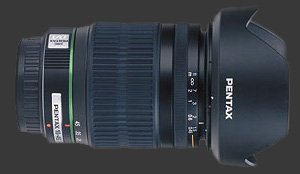
Next comes the needs. Needs vary in terms of angle of view, maximum aperture and other features like stabilization, tilt-shift, magnification and focus distance projection. Angle-of-view requirements translate into different focal lengths due to different sensor sizes. Examples here are quoted for the most common crop factors of 1.5 or 1.6. The equivalent need for full-frame DSLR cameras is noted as a tool-tip.
Think about the widest and narrowest angle desired angle of view. This is a personal choice. Some people always want a wider angle-of-view and some people always want to zoom further. If you already have a DSLR and lens, think about how often you are at the widest setting and wished to go wider because you cannot back up further. How about at the long end, how often do you feel the need to get closer? With a 1.5 crop, wide-angle requires 19 mmRoughly equivalent to 28 mm in 35 mm terms or less. Lenses starting from between 24 and 28 mmEquivalent to between 36 and 42 are mostly satisfactory. Ideally, portrait are taken with an 60 to 80 mm lensFrom 90 to 120 in 35 mm equivalence. Distant subjects and wildlife are easier to photograph with 200+ lenses.
Lenses also vary according to maximum aperture. A wider aperture means less depth-of-fieldConsequently a more blurry background and more light gatheringConsequently faster shutter-speeds. Remember that lenses are generally sharpest 2-stops down from their widest. An F4 lens is normally sharpest around F8, while a F2.8 lens around F5.6. An important feature is optical stabilization. It is an available on some lenses. Digital SLRs with built-in stabilization like the Sony Alpha and most Pentax K-series are advantaged since they obtain stabilization on all lenses at no additional cost. Most importantly, image quality varies tremendously between lenses. More expensive lenses are generally of higher quality than cheaper ones of similar specifications.
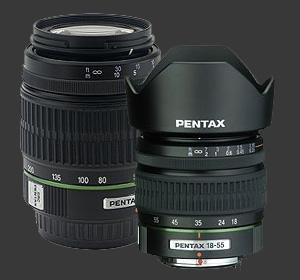
A set of one lens can be very light and fast to use since lens changes are not required. On the other hand, single lenses with long-zoom ranges are of limited quality and have narrow maximum apertures. Here are various single lens kits:
Canon
Pentax
 |
Wide-to-medium |
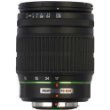 |
Wide-to-medium |
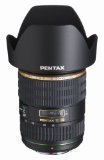 |
Open wide-to-medium |
 |
Open normal-to-medium |
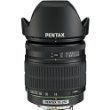 |
Wide-to-tele |
Sony
Nikon
With two lenses instead of one, it is easier to cover a wider-range of focal lengths or to cover a similar range with higher quality optics. Of course, the hassle is carrying both lenses and having to swap them. Swapping lenses in the field can be minimized by matching each lens to a different subject. This reduces the risk of getting dust on the camera sensor.
Several wide lenses exist to complement medium lenses. One can be chosen either to complement a quality medium lens or a regular medium-to-tele lens. A lens ending with a medium focal length can be paired with a telephoto lens for extending your reach without compromising quality at medium focal lengths. Here are some good lens pairs:
Canon
Pentax
  |
Wide-to-telephoto Pentax 17-70 F4 SDMPentax 55-300 F4-5.6  |
  |
Open wide-to-tele Pentax 50-135 F2.8 SDM  |
  |
Open normal-to-tele Sigma 24-70 F2.8Sigma 70-200 F2.8 |
Sony
  |
Wide-to-telephoto Sony 16-105 F3.5-5.6Sony 75-300 F4.5-5.6  |
  |
Normal-to-telephoto Sony 24-105 F3.5-4.5Sigma 100-400 F4  |
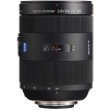  |
Open normal-to-tele Sony 24-70 F2.8 Carl ZeissSony 70-200 F2.8 SSM |
Nikon
  |
Open wide-to-medium Nikon 17-35 F2.8 |
  |
Wide-to-tele Nikon 18-55 F3.5-5.6 |
  |
Open normal-to-tele Nikon 24-70 F2.8Nikon 70-200 F2.8 VR |
Please Support Neocamera
All information on Neocamera is provided free of charge yet running this website is a huge endeavor. Purchases made via affiliate links found throughout the site help keep it running and up-to-date. There is no additional cost to you, so please consider buying via these links to our affilates:
If you found any information on this site valuable and did not purchase via our affiliate links, please considering donating via PayPal:
Any amount will be greatly appreaciated. Thank you for your support!
Ultra-Wide Angle Lenses
While many general purpose digital lenses start at wide-angles, none are truly ultra-wide lenses. An ultra-wide lens adds an unusual perspective to images, one that does not approach human vision. Note that no ultra-wide lens is stabilized. Thus, stabilizing an ultra-wide lens requires a camera with built-in stabilization. The widest ultra-wide lenses for 1.5X or 1.6X crop sensors start at 10mm, although 12mm is more common start. For full-frame sensors, Sigma has a 12-24mm which gives the widest field-of-view. The next widest field of view come from the Nikkor 14-24 F2.8 full-frame lens and the Zuiko 7-14 F4 Four-Thirds lens.
Updates
2024.04.03

Fujifilm X-T5 Review
Newest Fujifilm flagship boasting a 40 MP APS-C sensor, 5-axis IBIS with 7-stop efficiency, 15 FPS continuous drive, 6.2K Video capture, dual control-dials and dual SDXC UHS-II slots in a sturdy weatherproof and freezeproof body.
2023.11.20

Best Digital Cameras of 2023
Find out which are the Best Digital Cameras of 2023. All the new Mirrorless Digital Cameras from entry-level to high-end professional.
2023.07.10

Fujifilm X-H2 Review
40 Megapixels APS-C Hybrid Mirrorless Digital Camera with 7-stop IBIS. Fastest shutter ever and 8K video capture. Large builtin EVF with 0.8X magnification and 5.8 MP, plus an Eye-Start Sensor. Packed with features and large number of controls in a weatherproof and freezeproof body.
2023.05.07

Sony FE 20-70mm F/4G Review
Review of the unique Sony FE 20-70mm F/4G lens. The optical zoom of this lens spans ultra-wide-angle and medium focal-length coverage, making it one of the most versatile Full-Frame lenses on the market.
2023.01.15

Huion Inspiroy Dial 2 Review
Review of the Huion Inspiroy Dial 2 tablet, a medium sized drawing surface with dual dials and customizable buttons. Connects via USB-C or Bluetooth 5.0 with Windows, Linux and Android support.
2022.12.08

How to Pack for a Photo Trip
Find out how to pack for a travel photography trip, carry your gear safely while meeting airline regulations.
2022.11.13

Best Digital Cameras of 2022
The best digital cameras of 2022. A short list of the most outstanding models in their respective categories. Choose one for yourself or as a gift.
2022.09.21

Pentax DA* 60-250mm F/4 SDM Review
Review of the Pentax DA* 60-250mm F/4 SDM, the constant-aperture telephoto zoom with the highest zoom-ratio on the market.
2022.09.20

Pentax DA* 50-135mm F/2.8 SDM Review
Review of the Pentax DA* 50-135mm F/2.8 SDM, the lightest professional telephoto zoom native to the K-mount.
2022.09.10

Pentax DA* 11-18mm F/2.8 DC AW Review
Review of the Pentax DA* 11-18mm F/2.8 DC AW, the widest professional ultra-wide zoom native to the K-mount.
2021.11.24

50 Gifts Under $50 For Photographers in 2021
50 Gifts photographers will love. All for under $50 USD. 2021 Edition.
2021.11.17

Best Digital Cameras for 2021
Neocamera shows which are the very best Digital Cameras for 2021 in every category: Mirrorless, DSLR, Premium Compact, Ultra-Zoom and Rugged.
2024.04.03
2023.11.20
2023.07.10
2023.05.07
2023.01.15
2022.12.08
2022.11.13
2022.09.21
2022.09.20
2022.09.10
2021.11.24
2021.11.17
NEWS
2024.04.24

Megadap Ultimate Canon EF to Nikon Z Adapter
2024.04.24

Sony Custom Grid License
Technology
2024.04.16

Sony Launches Bright Ultra-Wide Compact Zoom
Lens
2024.03.27

Sigma Ultra-Bright Normal Mirrorless Lens
Lens
2024.03.27

Nikon Launches Full-Frame Super-Zoom Lens
Lens
2024.03.20

New Lens Statistical Comparisons
2024.03.14

Fujifilm Brings New Features to Instax Series
Instant Camera
2024.03.07

Leica Launches SL3 Full-Frame Mirrorless
Digital Camera
2024.02.22

Panasonic Unveils Full-Frame Travel-Zoom Lens
Lens
2024.02.21

Sigma Reveals 2 Extreme Full-Frame Lenses
Lens
2024.02.21

Sony Reveals Bright Compact Full-Frame Zoom
Lens
2024.02.20

Venus Launches First Autofocus Lens
Lens


